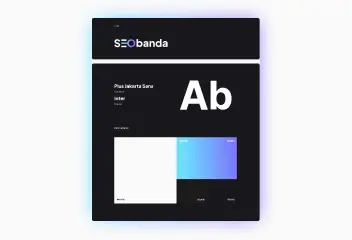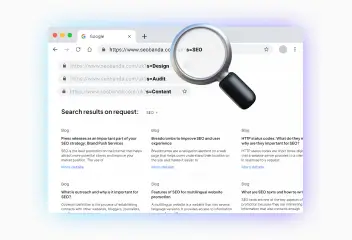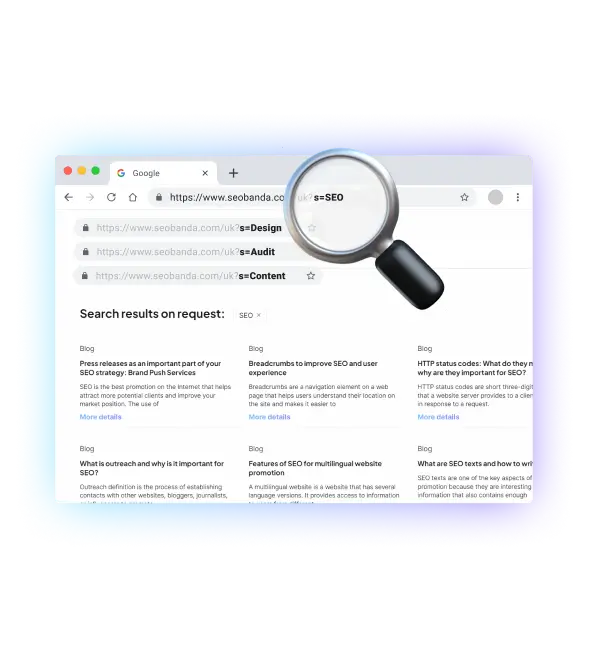What is a semantic core and what is it for?
The semantic core is the words and phrases that reflect the content and theme of your site. It’s like a paraphrase of your content in a few (or a few hundred, thousand) phrases. Everyone has heard the phrase “Tell me who your friend is and I’ll tell you who you are”. You can say the same thing: “Show me the semantic core and I’ll tell you what your site is about”.





What does the semantic core consist of?
- The semantic core consists of keywords in any interpretation. High-, medium-, and low-frequency words and phrases.
- Long-tail phrases: these are more specific keywords consisting of 3-5 or more words.
- Informational keywords: These are those that answer questions and provide useful information. For example: “How to transfer a website to another hosting service?”.
- Commercial keywords: those that contain the words “order”, “buy”, “purchase” and similar words that are aimed at a specific target action.
- Local keywords: This is the most important element of local SEO and is needed to promote physical stores, cafes, restaurants, etc. so that people can find a physical location near them.
- Brand keywords: contain the name of a brand or product. For example, “SEO agency SEObanda”.


How to create a semantic core?

To create a relevant semantic core, you need to do the following:
- Identify the topic. Start by understanding the topic of your website and the main services or products you offer.
- Collect the semantic core. Use special tools to collect keywords, such as Google Keyword Planner, Ahrefs, SEMrush, etc. Research what words and phrases people are searching for in your niche and which ones you can compete for.
- Competitor analysis. See what words your competitors are using. This can give you an idea of which words are most effective. It’s important to analyze competitors who have well-established SEO and understand how to use the semantic core correctly.
- Clustering of the semantic core. Divide the collected keywords into groups (clusters) by topic. This will help organize the content on your website in a more logical and user-friendly way.

Increase visibility
for your business: SEO solution for growth!


Why is the semantic core important?
Content optimization
- Relevance: The semantic core helps you create content that is relevant to users’ needs. It ensures that your content is relevant to the needs of potential customers.
- Structure: Keywords help organize the content on your website in a logical and user-friendly way. This includes distributing keywords across different pages, sections, and subsections of the site.
Improving the position of the site
- Ranking: Using relevant semantics helps your site to rise in search results, which is the main goal of any online business.
- Targeting: The semantic core allows you to target specific search queries and attract a larger target audience.
Planning a content strategy
- Topics: The semantic core helps you identify the main topics and sub-topics for creating content. This allows you to cover a topic in a more diverse and comprehensive way.
- Calendar: You can create a content plan and systematize the creation of content on your site. This allows you to constantly expand the semantic core and update the content to keep it relevant.
Improving the quality of content
- Content relevance: Using the exact wording that users are asking for allows them to find the information they need faster and stay satisfied with your site.
- Navigation: A properly clustered semantic kernel allows you to improve website navigation, making it intuitive.


The most common mistakes in the formation of the semantic core, tested in practice

- Incorrect choice of keywords. Using keywords that are too general can lead to a lot of competition and low relevance. For example, “phone” is an incomprehensible query, you cannot determine what exactly the user wants to see, so such words should be avoided. It is better to use more precise wording, for example, “iPhone 12 with 128 GB”.
- Ignoring synonyms. In addition to the words that are used most often, there are synonyms that are also popular, but they are often forgotten. For example, in addition to the word “phone”, “smartphone”, “gadget”, and the like are often used.
- Ignoring competitor analysis. This is the most serious mistake, because competitors have already (most likely) done market analysis and you can save time and effort and get much more information by analyzing competitors.
- Lack of clustering. If you don’t group keywords by topic, your site can be a mess and, most unpleasantly, cannibalization. This is the process when a large number of identical keywords are used on several pages. This can lead to Google filters and worsen the indexing of the site.
- Ignoring long-tail keywords. Quite often, when collecting the semantic core, people look at phrases that are searched quite rarely (100-200 queries per month), but if they have a long tail, they are, on the contrary, very useful keys. When people ask for a specific query, they already know what they need and are ready to make a conversion action (buy a product, order a service, etc.). And competition in such words is usually low. Therefore, you should pay attention to such keys and add them to your website, as they have a higher conversion rate.
- Lack of work with SEO tools. Manual collection, cleaning, and clustering of the semantic core is a huge amount of work, so it is better to use specialized services or contact professionals.

Increase visibility
for your business: SEO solution for growth!


Practical tips for creating a high-quality semantic core
- Research the queries through various tools such as Google Keyword Planner, Ahrefs, SEMrush, etc. This is done in order to cover all possible queries and make the semantic core as large as possible.
- Use different types of keywords: informational, commercial, navigation, local, etc. for each topic of your website.
- Cluster the semantic core and remove unnecessary keywords (for example, if you have collected the semantic core of your competitors, you should remove their branded keys).
- Analyze the semantic core of your competitors. They know in practice which words are better to use and you can get a lot of useful information by analyzing several competitors.
- Consider synonyms. Use not only the queries that users make, but also synonyms, related products, and any words related to your topic and relevant to your content.
- Create a detailed content plan. Based on the collected semantic core, create a publication plan and gradually expand the semantic core of your site. Create detailed specifications (including semantics, character count, anchors, meta tags, etc.).
- Optimize the content. Edit existing content (or create new, more relevant content) based on semantics. Add keywords organically and make the content more relevant to users’ queries.


Conclusion
The semantic core is all the key queries that users use to find information, goods, and services in your niche. Semantics is important for analyzing customer needs, optimizing your content, and improving conversions. To collect the semantic core, it is better to use competitor analysis or contact specialists for help.
You may also like it

Brand identity: The key to brand recognition and SEO success
Every product has its own unique feature that sets it apart from other brands. It could be a special font, a unique mascot, or an interesting logo with the right...

What is a dynamic URL and its impact on SEO
A dynamic URL (Uniform Resource Locator) is a web address that changes depending on the user's request or specific parameters. It differs from a static













